


Tellurium complexes with halogens
Tellurium chemistry is relatively unknown to most of the people and for that reason some experiments with this element are presented at this webpage. Tellurium is quite stable in oxidation state +4 and in this oxidation state its most well known form is the off-white tellurium dioxide.
Much less known is that tellurium in oxidation state +4 easily forms complexes with halide ions, which also can be prepared from aqueous solutions at low pH, but which easily hydrolyse on dilution with water. A gradual change of properties occurs when the halide goes from chloride through bromide to iodide. The complex is more stable for the more heavy halogen and the color of the complex also is more intense for the more heavy halogen.
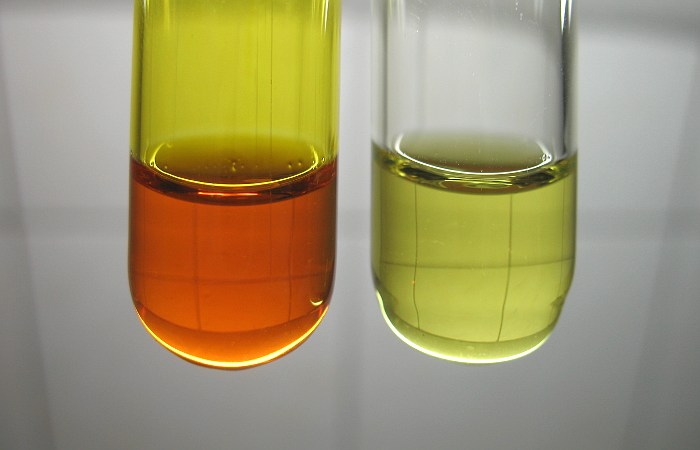
The complexes of tellurium are remarkably colorful as the picture above shows. In this webpage it is described how these complexes can be prepared and their behavior on dilution with water is shown.
![]()
![]() Required
chemicals:
Required
chemicals:
-
tellurium dioxide of good quality
-
sodium tellurite (or sodium hydroxide with tellurium dioxide)
-
concentrated hydrochloric acid (30% HCl by weight)
-
hydrobromic acid (40% HBr by weight)
-
dilute sulphuric acid
-
potassium iodide
-
sodium sulfite
![]() Required
equipment:
Required
equipment:
-
test tubes
-
beaker
![]() Safety:
Safety:
- The acids, used in this experiment are corrosive. Avoid contact with the skin and avoid breathing the fumes of concentrated hydrochloric acid. If there is contact with the skin, then rinse with some cold water.
- Tellurium compounds are toxic and exposure should be avoided.
-
 Another property
of tellurium compounds is that the human body metabolizes them to organic
tellurides which have an extremely strong repulsive odor. This is another
reason to be very careful with the tellurium compounds and avoid exposure.
Another property
of tellurium compounds is that the human body metabolizes them to organic
tellurides which have an extremely strong repulsive odor. This is another
reason to be very careful with the tellurium compounds and avoid exposure.
![]() Disposal:
Disposal:
- The tellurium waste should not be flushed down the drain. Collect all waste and bring this to a proper municipal waste processing facility.
![]()
The tellurium-based chemicals, used in this experiment
The chemicals, used in this experiment, were prepared from raw technical grade tellurium dioxide. The technical grade material contains a lot of insoluble impurities and colored metal ions. This material was purified by dissolving it in some excess amount of solution of sodium hydroxide, filtering all insoluble material and then adding dilute hydrochloric acid such that tellurium dioxide precipitates as an off-white precipitate. This was filtered and rinsed multiple times with distilled water and then dried. The resulting material is a light brown solid, which dissolves in a solution of sodium hydroxide, giving a clear and colorless solution. The picture below shows the purified tellurium dioxide.
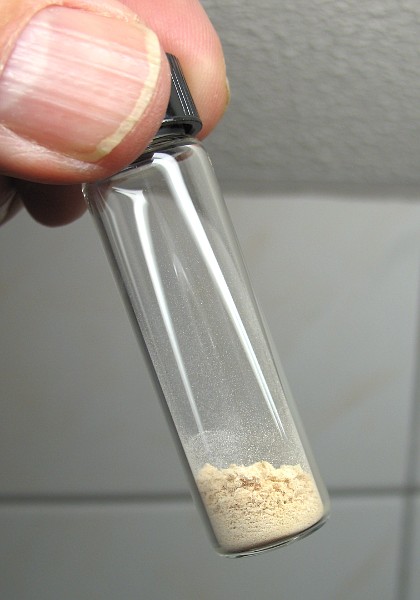
Another part of the impure tellurium dioxide was dissolved in as little as possible of a solution of sodium hydroxide, impurities were filtered and the solution allowed to evaporate to 10% of its original volume. When this is done, around 20% of all dissolved material crystallizes in the form of white crystals, which easily can be removed from the remaining impure liquid. Yield is low when using this method of purification, but the remaining chemical is of good purity. It is a white solid, containing also some carbonate (due to absorption of carbon dioxide from the air by the strongly basic solutions), but it is very pure with respect to heavy metals and other colored impurities. The picture below shows a picture of the sodium tellurite used in this experiment.
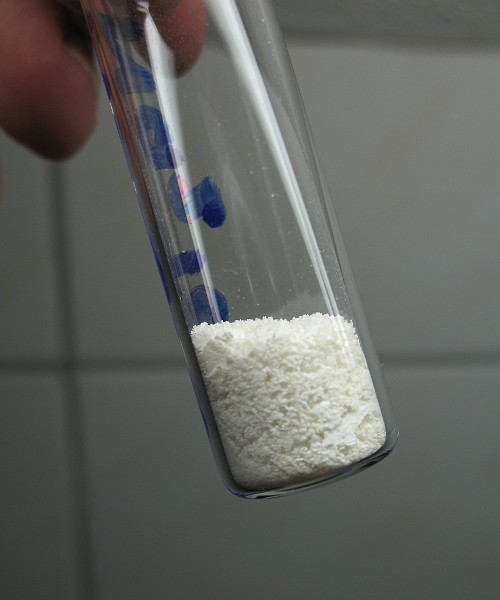
The chloro and bromo complexes
Making the chloro and bromo complexes is quite easy. Put a small amount of solid tellurium dioxide in a test tube and add a little amount of hydrochloric acid to one of these test tubes and a similar amount of hydrobromic acid to the other test tube. This results in the following:
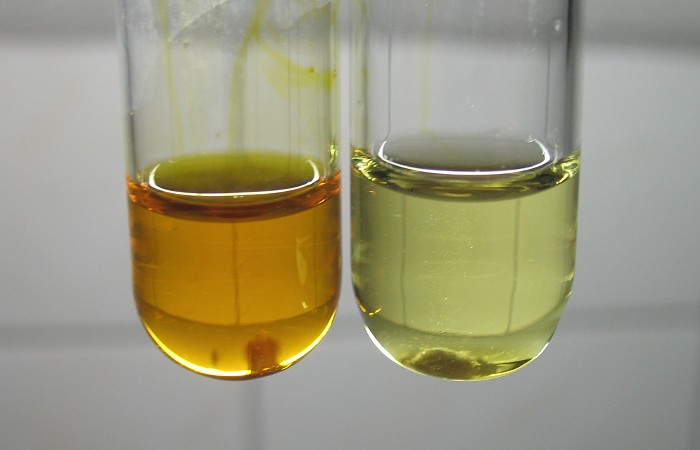
The picture above shows the test tube with hydrobromic acid at the left and the test tube with hydrochloric acid at the right. The solid tellurium dioxide still is visible.
When the test tubes are swirled carefully, then all of the tellurium dioxide slowly dissolves and the colors intensify. Especially the solution in hydrobromic acid obtains a remarkably intense color. Even the thin layer sticking to the glass has an intense yellow color.

The iodo complex
Preparation of the iodo complex also is very easy. This complex also is more stable and can even be prepared from dilute solutions with just a few percent of acid in them. Preparation can be done as follows:
![]() In one test tube, dissolve some sodium tellurite, together
with a small amount of sodium hydroxide in a small amount of water.
Alternatively, one also can use tellurium dioxide with sodium hydroxide, but the
process of dissolving then takes much more time. If the solution still is
somewhat opaque/white, then add a little bit more of sodium hydroxide.
In one test tube, dissolve some sodium tellurite, together
with a small amount of sodium hydroxide in a small amount of water.
Alternatively, one also can use tellurium dioxide with sodium hydroxide, but the
process of dissolving then takes much more time. If the solution still is
somewhat opaque/white, then add a little bit more of sodium hydroxide.
![]() In
another test tube dissolve some potassium iodide in 10% sulphuric acid. This
solution is colorless if perfectly pure, but due to aerial oxidation of iodide a
very faint yellow color usually is observed. This is no problem for this
experiment. Use so much acid, that it is certain that relative to the sodium
hydroxide there is a strong excess amount of acid. Also assure that the amount
of iodide is in large excess, relative to the amount of tellurium dioxide or
sodium tellurite.
In
another test tube dissolve some potassium iodide in 10% sulphuric acid. This
solution is colorless if perfectly pure, but due to aerial oxidation of iodide a
very faint yellow color usually is observed. This is no problem for this
experiment. Use so much acid, that it is certain that relative to the sodium
hydroxide there is a strong excess amount of acid. Also assure that the amount
of iodide is in large excess, relative to the amount of tellurium dioxide or
sodium tellurite.
![]() Pour the
contents of the test tube with the acidified iodide in the test tube with the
sodium tellurite. When this is done, a dark grey (almost black) precipitate is
formed. This experiment only succeeds if the final solution still is strongly
acidic, so there really must be excess of acid. If the final solution is basic
or neutral, then a white precipitate of tellurium dioxide is formed instead.
Pour the
contents of the test tube with the acidified iodide in the test tube with the
sodium tellurite. When this is done, a dark grey (almost black) precipitate is
formed. This experiment only succeeds if the final solution still is strongly
acidic, so there really must be excess of acid. If the final solution is basic
or neutral, then a white precipitate of tellurium dioxide is formed instead.
The precipitate is quite voluminous, but still it settles at the bottom fairly quickly. The liquid above the precipitate is brown, but as long as tiny particles of the precipitate are in that liquid it looks dark green instead of brown.
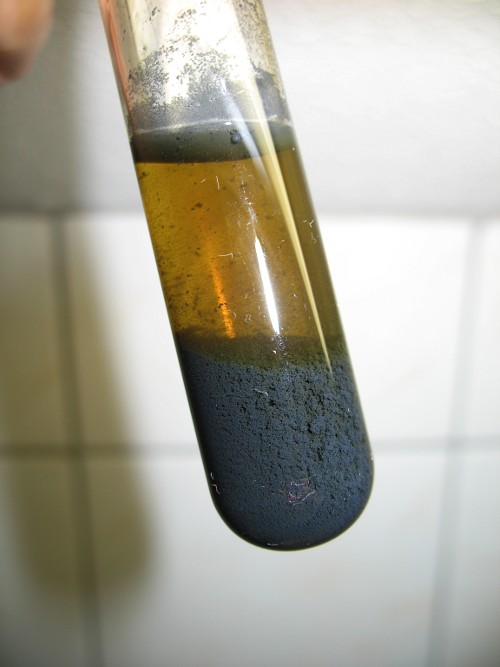
The black material is a iodo complex of tellurium. It resembles elemental tellurium which also can be precipitated from solutions of tellurium(IV), but this black precipitate formed by adding iodide certainly is not elemental tellurium. Iodide does not reduce the tellurium(IV) to elemental tellurium. This is shown further below.
The brown liquid was pipetted away from the black precipitate for more than 80%, leaving a dark mud behind. This dark mud was used in the next experiment with dilution with water.
If the iodide really reduced the tellurium(IV) to elemental tellurium, then the liquid above the precipitate would be much darker. A large excess amount of iodide was used and this would keep all iodine, produced in the redox reaction with tellurium(IV) in solution as tri-iodide ion. But the liquid only is pale brown, so if this color is due to the presence of iodine, then it is very dilute and this cannot account for formation of such a large amount of elemental tellurium. The lack of a lot of dissolved iodine is another piece of evidence that the black precipitate is not elemental tellurium.
![]()
Dilution of the complexes with water
All three complexes easily are hydrolysed when more water is added. Most stable is the iodo complex and least stable is the chloro complex.
The chloro complex already disappears when the solution is diluted with water to 5 times its own volume. The solution then becomes colorless and after some time it may become opaque due to separation of finely divided tellurium dioxide. The picture below shows the three complexes (chloro at left, bromo in the middle, iodo at the right). A lot of water was added to the chloro complex:
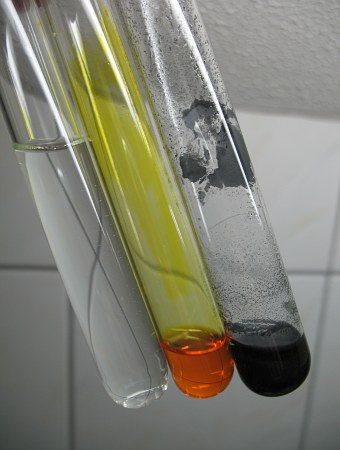
When a similar amount of water is added to the bromo complex, then the color of that also fades, but not completely:
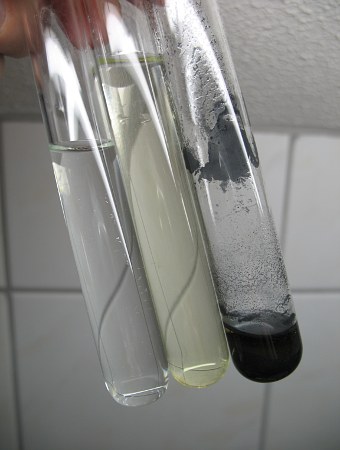
The picture shows that the diluted solution still is pale yellow. However, when the test tube is filled completely with water, then the solution becomes completely colorless. So, the bromo complex also hydrolyses, but for complete hydrolysis more water is needed.
The next two pictures show what happens if a similar amount of water is added to the black mud in the right test tube (only the test tube with the iodo complex now is shown). Initially, nothing seems to happen, just dispersion of the black material in the water. But after a minute or so, the liquid becomes lighter and the black particles dissolve. The left picture shows the result immediately after adding the water, the right picture shows the same test tube approximately 1 minute later.
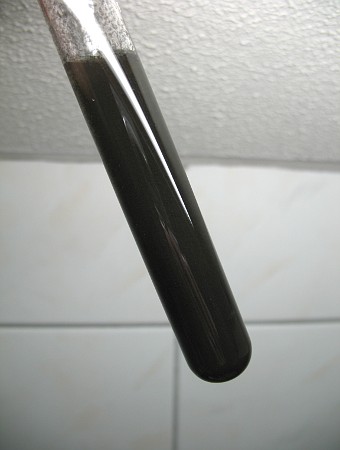
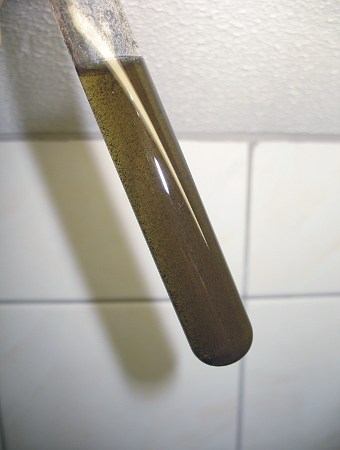
When the test tube is allowed to stand even longer, then the liquid remains brown and a small amount of solid material settles at the bottom.
Next, even more water was added, such that the test tube is almost completely filled with water. When this is done, then the remaining particles also dissolve and the brown color disappears within a minute.
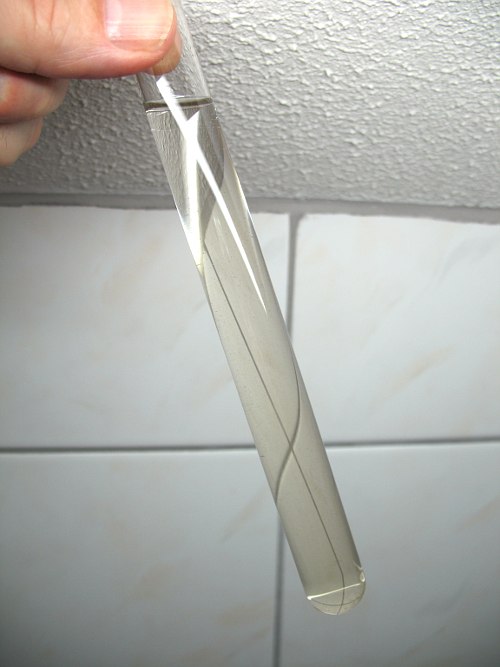
The picture above shows the result of adding more water, approximately one minute after adding the water and turning the stoppered test tube upside down a few times in order to have good mixing of the liquids.
When the test tube is allowed to stand for a few more minutes, then the liquid becomes completely colorless and slightly opalescent, due to formation of tellurium dioxide.
This final result shows that the iodo complex is much more stable with respect to hydrolysis than the other two complexes. Initially, the preparation of the complex already was done in a much less concentrated and much less acidic solution, and the dilution of the liquid also can be extended further before complete destruction of the complex occurs.
![]()
Proof that black material after adding iodide is not elemental tellurium
The experiment above already is a strong indication of the fact that the black material is not elemental tellurium. Simple dilution with water cannot redissolve elemental tellurium. But a control experiment was done just to be totally sure.
A fairly concentrated solution of sodium sulfite was prepared in very dilute acid, such that a weak smell of sulphur dioxide could be smelled above this solution. This solution then was added to the test tube with the dissolved iodo complex. The result is immediate formation of a black precipitate. Also some white precipitate is formed, due to formation of tellurium dioxide, but on mixing this quickly is converted to black tellurium as well.
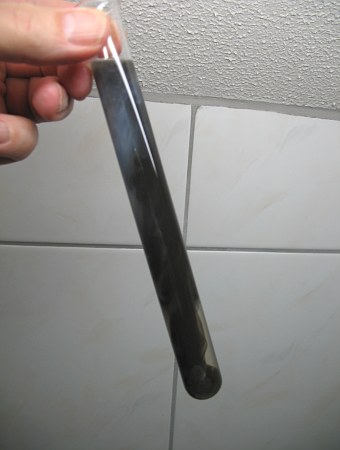
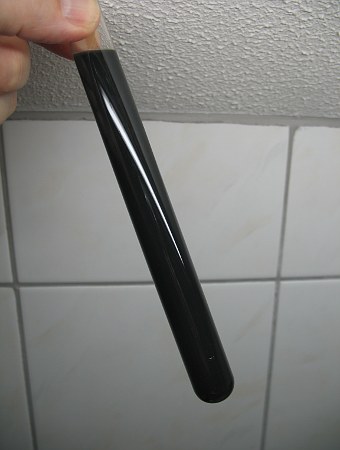
When this black solution is dumped in a beaker, containing 10 times as much water as the test tube, then the black color persists. Elemental tellurium is not hydrolysed nor oxidized and hence does not disappear on dilution.
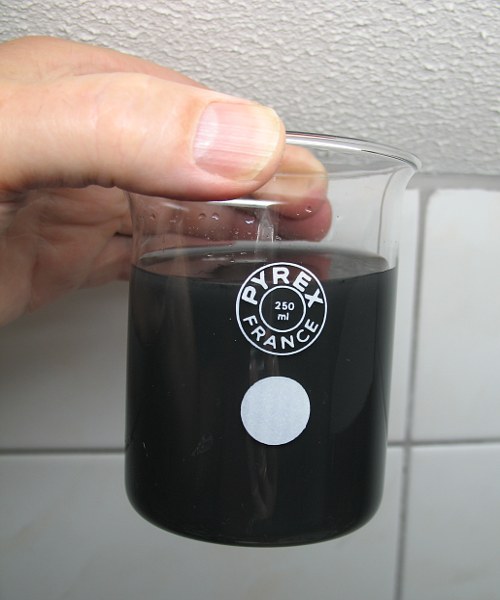
This test with sulfite demonstrates the difference between reduction to tellurium with sulfite and formation of a complex with iodide. Some literature states that tellurium in oxidation state is reduced by iodide ion in acidic solution, but this is not the case. This mistake, however, is understandable, because of the very similar appearances of the iodo complex and elemental tellurium.
![]()
Discussion of results
![]() Tellurium dioxide hardly is soluble in water. In strong hydrochloric acid and
hydrobromic acid it however does dissolve:
Tellurium dioxide hardly is soluble in water. In strong hydrochloric acid and
hydrobromic acid it however does dissolve:
TeO2 + 5H+ + 5X– ↔ HTeX5 + 2H2O (here X stands for Cl or Br)
The above equation is a simplified representation of what happens in reality. The equilibrium is through intermediate colorless oxohalide species like TeO2X– and protonated versions of this species, but the final colored compound is of the form HTeX5.
![]() With hydroiodic acid this reaction also occurs, but
when solid tellurium dioxide is added to an acidic solution of an iodide, then
it becomes covered by a black layer of hydrated HTeI5, and no further
tellurium dioxide dissolves. For this reason, the tellurium is brought in
solution in the form of a tellurite and this solution then is mixed with excess
of the acidic solution of an iodide.
With hydroiodic acid this reaction also occurs, but
when solid tellurium dioxide is added to an acidic solution of an iodide, then
it becomes covered by a black layer of hydrated HTeI5, and no further
tellurium dioxide dissolves. For this reason, the tellurium is brought in
solution in the form of a tellurite and this solution then is mixed with excess
of the acidic solution of an iodide.
![]() When a lot of water is added, then the equilibrium goes the other way around and
the complex is destroyed and finally, tellurium dioxide is formed again.
When a lot of water is added, then the equilibrium goes the other way around and
the complex is destroyed and finally, tellurium dioxide is formed again.
The information about the tellurium halide complexes is very scarce. On the internet mention is made of complexes of the form HTeX5, but the information is very scattered and incomplete. A more through description can be found in the 1951 reprint of the book "The Chemical Elements and their Compounds" by N.V. Sidgwick, volume 2, pages 993 and 994. The observed colors match the descriptions given in this book.